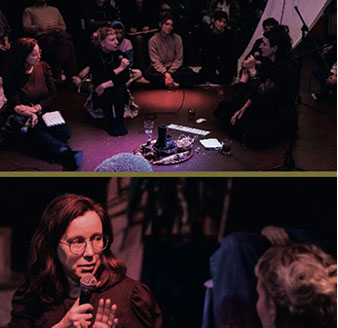MENU

photos: Emma Spannenberg
Ecofeminism in Practice: Ritual as Medium, Art as Message
by Roma Kwiatkiewicz
Dec 19, 2024
Mid-winter, het Resort hosted a three-way conversation moderated by Klaudija Ylaitė—an artist and researcher—featuring Kim Knibbe, an Associate Professor of Sociology and Anthropology of Religion at RUG, and Dajana Heremic, an artist and an activist. The discussion explored the intersections of ritual, ecofeminism, and art, inspired by Klaudija’s ongoing research on these topics.
Worth mentioning—the talk was preceded by Dajana’s ancestral skillshare workshop, Weaving Stories. For those who participated, the practice came before theory, which was only explored later during the conversation.
To begin with the artist: Dajana’s work is rooted in her deep connection to wilderness and nature, the land, and all the life it encompasses (=biocentricity). She works across various mediums, but the unifying thread (pun intended) in all her practice and work is ritual. It structures her art and activism, shaping her solitary and community-based work.
So what does it mean to use ritual as a medium? This is a good departure point for theory. In her research, Klaudija observed that both art and ritual are thought to hold great potential for societal change. Both require commitment—a word that repeatedly surfaced during the conversation. The key distinction between participating in a ritual and theorizing about it is embodiment. This is where the gap between research and praxis emerges. “When asked to participate in a ritual, you always do it as a particular, embodied person,” Kim noted. This can be challenging, especially when considering socially sanctioned rituals that one may feel obliged to partake in, even when their underlying values are not personally aligned (think of, for instance, the consumerist dimension that Christmas has taken on). After all, what one is often asked to embody in ritual is what Turner calls the fundamental values of culture.
Ecofeminism analyzes the relationship between humans and the natural world, drawing parallels to the oppressive gender structures historically used to exploit various groups of people. If both art and ritual share a commitment-driven nature, ecofeminism commits to recognizing all life as intrinsically (1) valuable and (2) interconnected. Reviving practices that foster a connection to nature—such as attentiveness to materials, as well as creating symbols that reflect a biocentric approach—can serve as both a commitment to ecofeminist values and a way to practice art and fostering communities, as exemplified by Dajana’s work.
How can we sum up the intersection of ritual, art, and ecofeminism? The boundary between ritual and art can be blurred, and for many, distinguishing between them is challenging. The conversation raised the idea that while art emerges from embodied values and internal processes, each artist defines their guiding question. For Dajana, for instance, ecofeminism inspires or provides a framework for these values. Ritual is the how. The possibilities are endless, and the effects—powerful, for both art and praxis alike and perhaps, to synthesize, as a practice of art.
about
Roma Kwiatkiewicz (Poland), studied literature and journalism at RUG. Writes for work, reads for fun.
Klaudija Ylaite is a performance artist and a researcher in the field of cultural analysis. Through the interdisciplinary combination of arts-based, autoethnographic, and discourse analysis research methodologies, she investigates the intersections between performance arts, ecofeminism, and ritual practice. The main focal point of her research is twofold; the development of new methods to alleviate alienation and disembodiment brought about by the imminent threat of social and environmental destruction, and the re-acknowledgement of archaic methods and systems of interconnectivity that can best be reimplemented to counter the distress, overwhelm, and apathy that arises in our current (environmental) crisis.
Dajana Heremic is an artist, mother and both teacher & student of the wild, living and working from a profound love for the earth and a deeply animistic experience of the world – to her this is true anarchy! In exploring prehistoric Europe & reclaiming the cyclical & dark of (our) nature she finds meaning. Through visual and magical arts & rewilding, she’s weaving biocentrism, ecofeminism, ceremony, earth skills, folklore and the occult into her daily life. As a refugee of war, the kinship with the other-than-human world, since her childhood, deepened the sense of place, belonging and the radical meaning of home.
Kim Knibbe is an Associate Professor of Anthropology and Sociology of Religion at Groningen University. Her curiosity is guided by the question of how people navigate between what they consider to be 'given' and what they believe to be human-made and therefore subject to change. Her recent research has used anthropological approaches to examine the intersections of sexuality, religion, and secularism. Previous research has focused on Catholicism and spirituality in the Netherlands and Nigerian Pentecostalism in Europe and the Netherlands. She has also published a series of theoretical and methodological reflections on studying religion ethnographically.
studium resort is made possible by Pictoright Fund